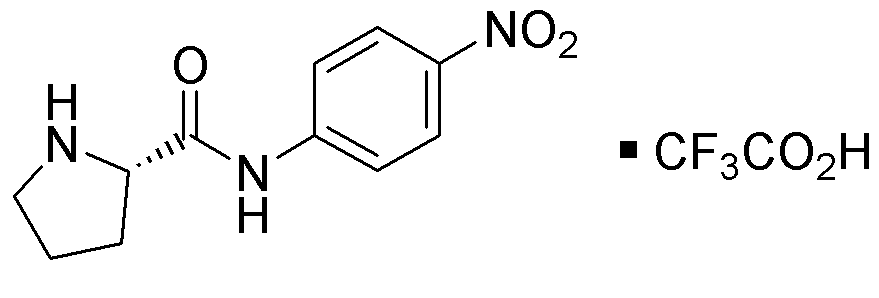H-Pro-pNA·TFA is widely utilized in research focused on:
- Enzyme Activity Assays: This compound serves as a substrate for various proteases, allowing researchers to measure enzyme activity and kinetics effectively.
- Drug Development: It plays a crucial role in the pharmaceutical industry for screening potential drug candidates, particularly in the development of protease inhibitors.
- Biochemical Research: Used in studies involving protein interactions, it helps scientists understand the mechanisms of action for various biological processes.
- Diagnostic Applications: The compound is beneficial in developing assays for disease markers, aiding in the early detection of certain health conditions.
- Educational Purposes: It is often used in academic laboratories for teaching purposes, providing students with hands-on experience in biochemical techniques.
Informations générales
Propriétés
Sécurité et réglementation
Applications
H-Pro-pNA·TFA is widely utilized in research focused on:
- Enzyme Activity Assays: This compound serves as a substrate for various proteases, allowing researchers to measure enzyme activity and kinetics effectively.
- Drug Development: It plays a crucial role in the pharmaceutical industry for screening potential drug candidates, particularly in the development of protease inhibitors.
- Biochemical Research: Used in studies involving protein interactions, it helps scientists understand the mechanisms of action for various biological processes.
- Diagnostic Applications: The compound is beneficial in developing assays for disease markers, aiding in the early detection of certain health conditions.
- Educational Purposes: It is often used in academic laboratories for teaching purposes, providing students with hands-on experience in biochemical techniques.
Documents
Fiches de données de sécurité (FDS)
La FDS fournit des informations de sécurité complètes sur la manipulation, le stockage et l’élimination du produit.
Spécifications du produit (PS)
Le PS fournit une description complète des propriétés du produit, notamment sa composition chimique, son état physique, sa pureté et les exigences de stockage. Il détaille également les plages de qualité acceptables et les applications prévues du produit.
Certificats d'analyse (COA)
Recherchez des certificats d'analyse (COA) en saisissant le numéro de lot du produit. Les numéros de lot et de lot se trouvent sur l'étiquette d'un produit, après les mots « Lot » ou « Lot de fabrication ».
Numéro de catalogue
Numéro de lot/série
Certificats d'origine (COO)
Ce certificat d'exploitation confirme le pays dans lequel le produit a été fabriqué, et détaille également les matériaux et composants utilisés et s'il est issu de sources naturelles, synthétiques ou autres sources spécifiques. Ce certificat peut être requis pour les douanes, le commerce et la conformité réglementaire.
Numéro de catalogue
Numéro de lot/série
Fiches de données de sécurité (FDS)
La FDS fournit des informations de sécurité complètes sur la manipulation, le stockage et l’élimination du produit.
DownloadSpécifications du produit (PS)
Le PS fournit une description complète des propriétés du produit, notamment sa composition chimique, son état physique, sa pureté et les exigences de stockage. Il détaille également les plages de qualité acceptables et les applications prévues du produit.
DownloadCertificats d'analyse (COA)
Recherchez des certificats d'analyse (COA) en saisissant le numéro de lot du produit. Les numéros de lot et de lot se trouvent sur l'étiquette d'un produit, après les mots « Lot » ou « Lot de fabrication ».
Numéro de catalogue
Numéro de lot/série
Certificats d'origine (COO)
Ce certificat d'exploitation confirme le pays dans lequel le produit a été fabriqué, et détaille également les matériaux et composants utilisés et s'il est issu de sources naturelles, synthétiques ou autres sources spécifiques. Ce certificat peut être requis pour les douanes, le commerce et la conformité réglementaire.

